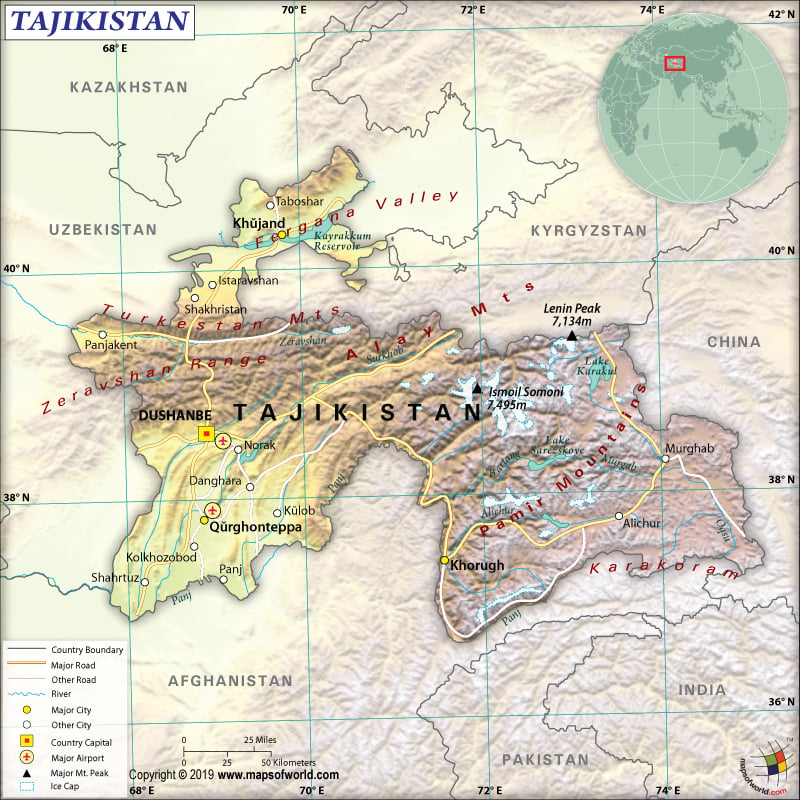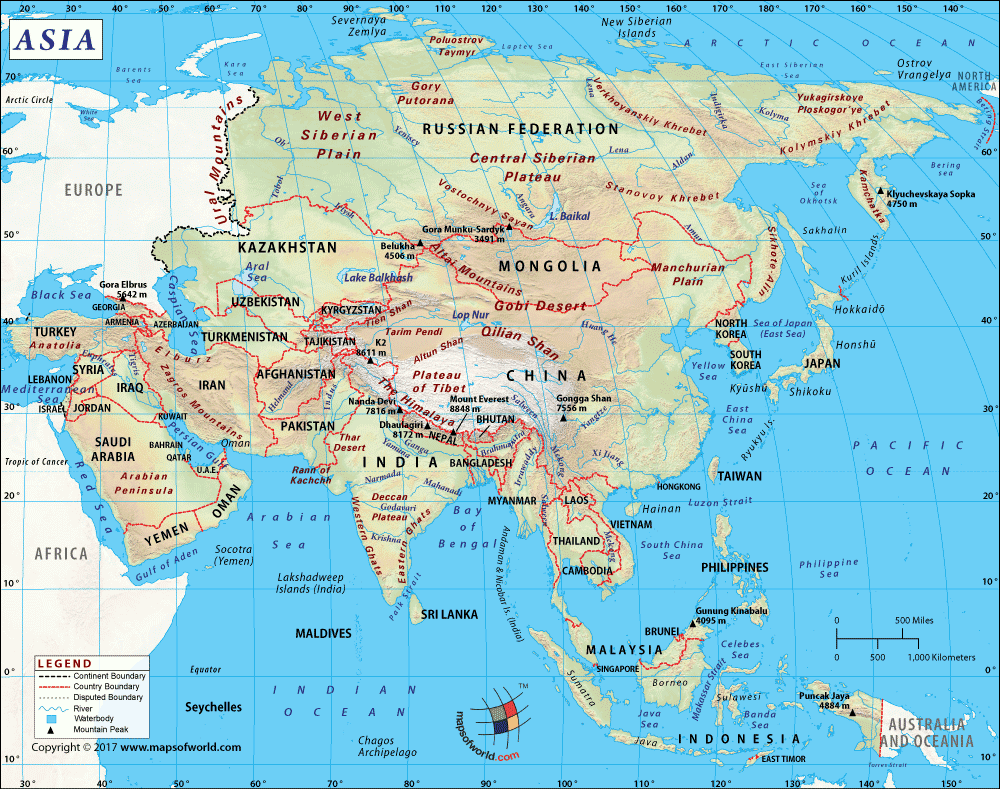What are the Key Facts of Tajikistan?

|
Official Name |
Republic of Tajikistan |
|
Continent |
Asia |
|
Capital |
Dushanbe |
|
Largest City |
Dushanbe |
|
Coordinates |
39.000000, 71.000000 |
|
Area |
55,637 sq. mi (144,100 sq. km) |
|
Land Boundaries |
2,566 mi ( 4,130 km) |
|
Coastline |
0 mi ( 0 km) landlocked |
|
Currency |
Somoni (TJS) |
|
Neighboring Countries |
Uzbekistan, Kyrgyzstan, China, Afghanistan |
|
Population |
9,275,827 (2019 est.) |
|
Official Languages |
Tajik |
|
Major Religion |
Islam |
|
National Day |
9 September (Independence Day) |
|
National Anthem |
“Surudi milli” |
|
Form of Government |
Unitary dominant-party presidential constitutional republic |
|
President |
Emomali Rahmon |
|
Prime Minister |
Kokhir Rasulzoda |
|
GDP per capita (PPP) |
$ 3,443.7 (World Bank, 2018) |
|
GDP per capita (nominal) |
$ 826.6 (World Bank, 2018) |
|
HDI |
0.65 (2017), Rank: 127 |
|
Literacy Rate (%) |
99.80 (UNESCO, 2014) |
|
Space Agency |
NA |
|
Military Expenditure Ranking |
NA (SIPRI, 2017) |
|
No. of Olympic Medals |
4 (as of 2018) |
|
Driving Side |
right |
|
Calling Code |
+992 |
|
Time Zone |
UTC+5 (TJT) |
|
Internet TLD |
.tj |
Where is Tajikistan?
Tajikistan is a Central Asian country that is located to the west of China and the south of Kyrgyzstan.
What is the Geography of Tajikistan?
Tajikistan is spread over a total area of 144,100 sq. km (55,637 sq. mi), out of which 141,510 sq. km (54,637 sq. mi) is land area and only 2,590 sq. km (1,000 sq. mi) is water area. It has a total land boundary of 4,130 km (2,566 mi). Tajikistan shares its land boundary with 4 countries: Afghanistan (1,357 km or 843 mi) to the south, Uzbekistan (1,312 km or 815 mi) to the west, Kyrgyzstan (984 km or 611 mi) to the north, and China (477 km or 296 mi) to the east. As it is a landlocked country, there is no coastline.
Further, almost the entire landform of Tajikistan is mountainous. While the northern parts are dominated by Alay Range, the southeastern parts are dominated by Pamir Mountains. The mean elevation of the country is 3,186 m (10,453 ft). Qullai Ismoili Somoni is the highest elevation point at 7,495 m (24,590 ft). The lowest point is Syr Darya (Sirdaryo), which is 300 m (984 ft) high.
Moreover, the landform is characterized by numerous mountain chains with dense maze of cold-water rivers forming deep valleys. The Fedchenko Glacier (the largest non-polar glacier in the world) surrounds the highest peaks of Tajikistan, covering 700 sq. km (270 sq. mi).
In addition, the major mountains of Tajikistan are Ismail Samani Peak, Pik Yevgenii Korzhenevskoy, Karl Marx Peak, Pik Garmo, Pik Patkhor, etc. The major rivers are Amu Darya, Syr Darya, Bartang, Gunt, Kofarnihon (Kafirnigan), and many more. Most important lakes are Kayrakum (Qairoqqum) Reservoir (Sughd); Iskanderkul and Kulikalon (Fann Mountains); Bulunkul, Drumkul, Karakul, Rangkul, Sarez (Pamir), etc.
Furthermore, the climate of Tajikistan is characterized as continental, subtropical, and semiarid. In some parts, desert areas are also there. With change of elevation, drastic climatic changes can be found. Though mountains act as a shield from the Arctic air masses, the Fergana Valley and other lowlands get freezing cold temperature for over 100 days every year.
The highest average temperatures are found in the arid climate of subtropical southwestern lowlands. The average temperatures at the lower elevations of Tajikistan range between 23 °C and 30 °C (73.4 °F and 86.0 °F) in July and between −15 °C and −20 °C (5 °F and −4 °F) in January. In the eastern Pamir region, the average temperature ranges between 5 °C and 10 °C (41 °F and 50 °F) in July and between −15 and −20 °C (5 and −4 °F) in January.
While the Kafernigan and Vakhsh valleys in the southern parts get 500 to 600 mm (19.7 to 23.6 in) of rainfall, the mountainous regions get 1,500 mm (59.1 in) of rainfall. The Fedchenko Glacier gets an average 223.6 cm (88.0 in) of snowfall every year. The eastern Pamir region gets less than 100 mm (3.94 in) of rainfall every year. Most of the rainfall takes place in the winter and spring seasons.
What is the Economy of Tajikistan?
As a matter of fact, Tajikistan’s economy is predominantly poor. It had a nominal GDP of US$7.523 billion with an annual growth rate of 7.3% in 2018. The higher growth trajectory in the recent years (especially in 2018) is because of high public investment in the energy sector, coupled with high private consumption. The World Bank reports suggest that in the medium term, the growth rate will remain more than 6% per annum. The more than average economic growth will be because of the substantial increase in public investment, highly favorable commodity prices, and a gradual recovery of domestic lending.
In 2018, the external position of Tajikistan deteriorated because the country had to import machinery and construction materials for boosting its energy sector. Significant fall in the international prices of the minerals (main export items of Tajikistan), adversely affected the external position. The country accounted for 2.6% FDI of GDP (thanks mainly to the Chinese investment in mining sector).
The economy of Tajikistan is plagued by severe poverty. 32% of the population was living below the national poverty line in 2017. As per Asian Development Bank, 3.7% of the population sustains their livelihood below US$1.90 per day.
What is the Transportation System of Tajikistan?
The main transport system in Tajikistan is roadways, which is 30,000 km (18,641 mi) across the country. Almost all the passenger transport (over 90%) takes place on automobiles. 80% of the total domestic freight transport is carried out on roadways.
Some of the major highways crisscrossing the country are Dushanbe-Chanak along the Uzbekistan border, Kurgan-Tube-Nizhny Pyanj along the Afghanistan border, Dushanbe-Kulma along the Chinese border, and Pakistan-Afghanistan-Tajikistan Highway. The main roadway transportation systems include Marshrutka minibuses and taxis (often shared).
Tajikistan has 680 km (423 mi) long railways and 200 km (124 mi) of waterways (mostly on Vakhsh River). There are 24 airports in the country, out of which 17 have paved runways and 7 have unpaved ones.
What International Organizations is Tajikistan part of?
WTO, IMF, UN, Interpol, ILO, WHO, ADB, CICA, CIS, CSTO, EAEC, EAPC, EBRD, ECO, FAO, G-77, GCTU, IAEA, IBRD, ICAO, ICCt, ICRM, UNESCO, IDA, IDB, IFAD, IFC, UNIDO, IFRCS, UNWTO, IOC, IOM, IPU, ITSO, UNCTAD, ITU, MIGA, OIC, OPCW, OSCE, PFP, SCO, UPU, WCO, WIPO, WMO, EITI (candidate country), ICC (NGOs), ISO (correspondent), NAM (observer), WFTU (NGOs)

